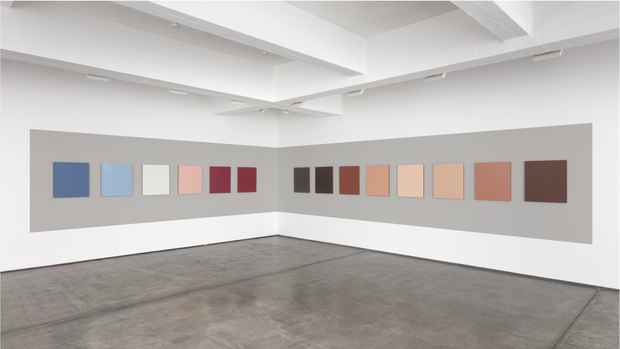Bernd and Hilla Becher, Sarah Charlesworth and Sherrie Levine Exhibition
Paula Cooper Gallery "524 W 26th St"

[Image: Sherrie Levine "Salubra 3" (2007) oil on mahogany and wall paint, 14 parts: 27 x 27 in., overall dimensions variable; painted rectangle on wall 65 in. height, length variable]
This event has ended.
Curated by Sherrie Levine
Paula Cooper Gallery presents an exhibition of works by Bernd and Hilla Becher, Sarah Charlesworth, and Sherrie Levine. Curated by Sherrie Levine, the exhibition brings together three related approaches to conceptual image-making, (post-)modernism, and the genre of the still life—understood both as a depiction of everyday inanimate objects, foods or flowers, and in a broader sense, as a formal representation of a specific time and place through its cultural artifacts.
Beginning in 1959, Bernd and Hilla Becher pursued a project of systematically documenting industrial architectural forms—an objective that took inspiration from the precisionist approach of the Neue Sachlichkeit (New Objectivity) artists August Sander, Karl Blossfeldt, and Albert Renger-Patzsch of the 1920s. Post-war Germany’s ubiquitous cooling towers, gas tanks, blast furnaces, and grain elevators—remnants of a fevered industrialization—provided the Bechers with the raw matter for their “typologies,” an effort to visually organize and render comparable the unique details of each structure and the intricate relationship between form and function. For the artists, these typologies were conceptual categories based on the general ideas used to sort a large body of information. “We didn’t really see it as artists, we saw it as something like natural history,” Hilla Becher noted in 2012. “So we also used the methods of natural history books, like comparing things, having the same species in different versions.” In the twilight of the industrial age, this loving census of steel and cement structures charts the outlines of a still life of modernity.
In 2006, Sarah Charlesworth produced her Concrete Color series—still life inspired photographs of precisely ordered dishes of hand-mixed paint. Set against white or gray backgrounds and completed with lacquered frames, the images visualize classical theories of color as well as contemporary tools in digital photography. “I’m interested in the idea of using art materials, the medium, as the subject and really examining the formal elements of art-making as content,” the artist noted. In Munsell Tree and Ostwald Triangle, Charlesworth reproduces early twentieth-century color systems, respectively theorized by the American inventor Albert H. Munsell and the German chemist Wilhelm Ostwald. In RGB Cube, she punctuates the eight corners of a Necker cube with various pigments—a nod to Gestalt psychology and the study of spatial interpretation in visual representation. Within other works, such as CYM Gray and Color Patch, Charlesworth embeds a Kodak Gray Scale or Color Control Patch that is mirrored in the configuration of the potted paints. Reflecting and questioning commercial tools and standards, the works reveal the constructed nature of photography—a conceptual investigation that Charlesworth pursued throughout her career.
Sherrie Levine’s Salubra 3 reference color charts produced by renowned architect Le Corbusier for the Swiss wallpaper company Salubra in 1931. Published as an interactive design guide, Le Corbusier’s collection included twelve ‘Clavier de couleurs,’ or ‘Color Keyboards’—each consisting of a different combination of the forty-three ideal tones in his suite. The architect believed that specific shades produced specific effects and could thereby alter a person’s perception of space. Identifying functions that could be applied to different shades—including psychological effects, weight, depth, perception, and unity—he created the color palettes, or keyboards, to reflect each of these. The fourteen monochrome panels of Salubra 3 represent Le Corbusier’s third color keyboard. Levine’s postmodern revisiting of Le Corbusier, a kind of über-realistic still life, proposes a heightened, sensuous experience of the architect’s chromatic range, while also laying bare for reappraisal the utopian ideals at the core of High Modernism and the International Style.
Media
Schedule
from February 29, 2020 to April 04, 2020
Opening Reception on 2020-02-29 from 18:00 to 20:00